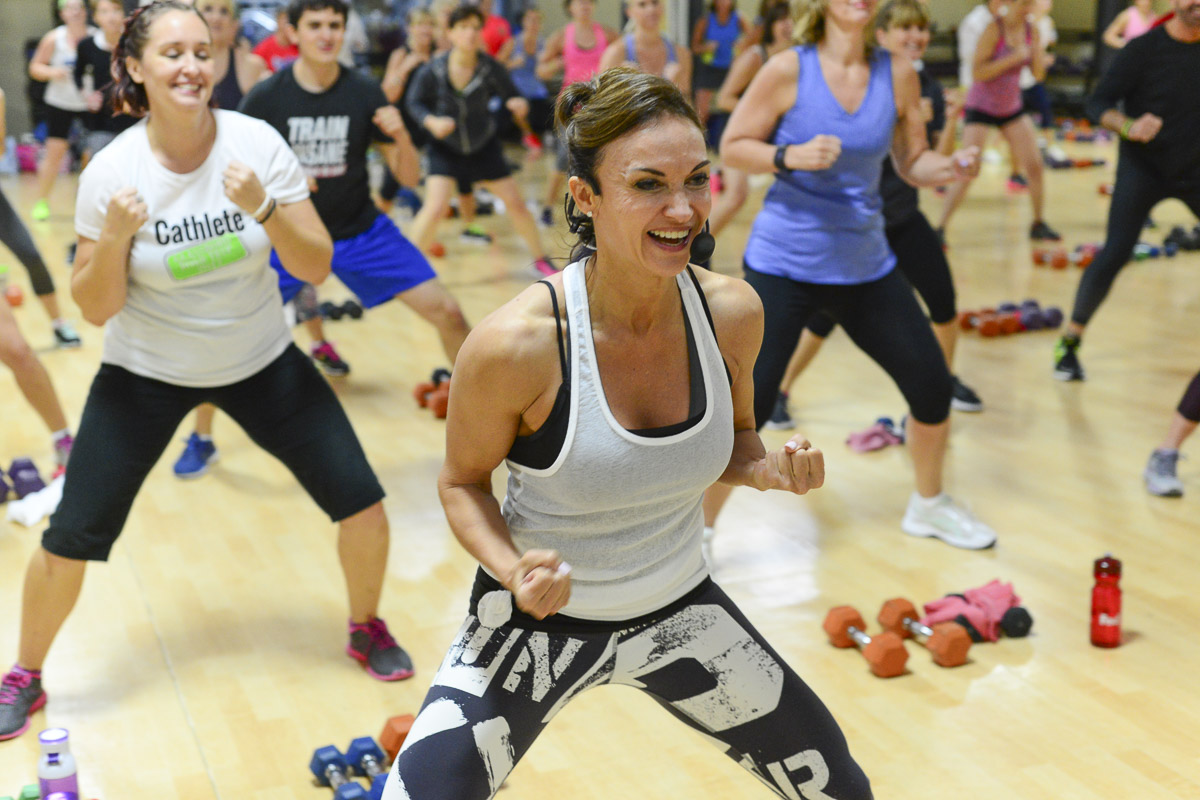

Featured
What Exercise Burns Fat
Modified: January 2, 2024
Discover the best featured exercise that burns fat and helps you reach your fitness goals.
Introduction
Welcome to the world of fat burning exercises! If you’re on a journey to shed those extra pounds and achieve a leaner physique, you’ve come to the right place. In this article, we’ll explore a variety of exercises that are specifically designed to target and burn fat.
When it comes to fat loss, it’s important to understand that exercise is just one piece of the puzzle. A balanced diet, proper sleep, and consistency are equally crucial in achieving your weight loss goals. However, incorporating the right types of exercises into your routine can greatly accelerate your progress.
Before we dive into the specific fat-burning exercises, let’s briefly explain how fat burning works. When you engage in physical activity, your body burns calories for energy. If you’re consistently burning more calories than you consume, your body begins to tap into its fat stores for fuel, thus leading to fat loss.
Now, let’s explore some of the most effective fat-burning exercises that can help you shed those unwanted pounds:
Understanding Fat Burning
Before we jump into the specific exercises that help burn fat, it’s important to understand the science behind fat burning. Our bodies store excess calories as fat, and when we engage in physical activity, our bodies use these stored fats as fuel.
When we talk about burning fat, we’re essentially referring to the process of utilizing stored fat as an energy source. This process is influenced by various factors such as exercise intensity, duration, and frequency, as well as individual factors like metabolism and genetics.
A common misconception is that spot reduction, or targeting fat loss from specific areas of the body, is possible through exercise. Unfortunately, it’s not. When we engage in physical activity, our bodies burn fat from all over, and it’s impossible to choose where the fat comes from.
However, certain types of exercises are more effective in promoting fat burning than others. High-intensity exercises and cardiovascular workouts, for example, are known to elevate heart rate and increase calorie burn during and after the workout, thus aiding in fat loss.
In summary, understanding fat burning involves knowing that it’s a process of using stored fat as energy during physical activity. While spot reduction is not possible, certain exercises can help promote overall fat loss.
High-Intensity Interval Training (HIIT)
High-Intensity Interval Training, commonly known as HIIT, is a popular exercise technique that has gained immense popularity for its ability to effectively burn fat in a shorter amount of time. HIIT involves alternating short bursts of intense exercise with brief recovery periods.
The key to HIIT’s fat-burning benefits lies in its ability to elevate the heart rate and keep it high throughout the workout. This constant change in intensity helps boost the metabolism and increases the body’s calorie burning potential both during and after the workout.
A typical HIIT session can include exercises like jumping jacks, burpees, mountain climbers, squat jumps, and high knees. The high-intensity intervals usually last for 20-60 seconds, followed by short periods of rest or low-intensity recovery exercises.
Research has shown that HIIT not only burns more calories in a shorter amount of time but also promotes the production of human growth hormone (HGH), which aids in fat loss and muscle growth. Additionally, HIIT workouts can be tailored to individual fitness levels, making it accessible to beginners as well as seasoned athletes.
One of the advantages of HIIT is that it can be done with little to no equipment, making it convenient for those who prefer to exercise at home or while traveling. Additionally, the flexibility of HIIT allows for creativity and variation in exercise selection, keeping workouts exciting and challenging.
It’s important to note that HIIT workouts are highly intense and may not be suitable for everyone, especially those with certain health conditions or injuries. It’s always advisable to consult with a healthcare professional before incorporating HIIT into your fitness routine.
Incorporating HIIT workouts into your exercise regimen can lead to significant improvements in cardiovascular fitness, increased calorie burn, and ultimately, fat loss. So, if you’re looking to burn fat efficiently and maximize your workout time, HIIT is definitely worth a try.
Cardiovascular Exercises
Cardiovascular exercises, also known as cardio or aerobic exercises, are another effective way to burn fat. These exercises increase your heart rate and breathing, promoting the efficient circulation of oxygen and nutrients to your muscles.
When it comes to fat burning, cardio exercises are great because they help you burn a significant number of calories in a single session. This calorie deficit, when coupled with a healthy diet, can lead to fat loss over time.
There are several types of cardiovascular exercises to choose from, each with its own benefits and variations. Running, jogging, swimming, cycling, and dancing are just a few examples of cardio exercises that can help elevate your heart rate and burn fat.
The duration and intensity of your cardio workout will depend on your fitness level and goals. Beginners can start with shorter sessions and gradually increase the duration and intensity over time. Aim for at least 150 minutes of moderate-intensity cardio exercise or 75 minutes of vigorous-intensity exercise per week.
In addition to traditional cardio exercises, incorporating high-intensity interval training (HIIT) into your cardio routine can further enhance fat burning. HIIT can be applied to various cardio activities, such as sprint intervals during a run or intense bursts of swimming laps.
It’s important to vary your cardio workouts to prevent boredom and keep challenging your body. You can try different forms of cardio exercises on different days or alternate between activities to keep things interesting.
Remember that consistency is key when it comes to cardiovascular exercises. Aim to incorporate cardio workouts into your routine at least three to five times per week to see noticeable improvements and fat loss results.
Don’t forget to listen to your body and gradually increase the intensity and duration of your cardio workouts. It’s also important to choose activities that you enjoy, as this will increase the likelihood of sticking to your routine and making cardio exercises a regular part of your lifestyle.
So, lace up your sneakers, grab your bike, or put on your dancing shoes. Cardiovascular exercises are a fun and effective way to burn fat, improve cardiovascular health, and boost your overall fitness levels.
Strength Training
While cardio exercises are excellent for burning calories and improving cardiovascular health, strength training plays a crucial role in fat burning and reshaping your body composition. Strength training, also known as weight training or resistance training, involves working your muscles against resistance to build strength and endurance.
One of the primary benefits of strength training for fat burning is that it helps increase lean muscle mass. Muscle is more metabolically active than fat, meaning that it burns more calories even at rest. By increasing muscle mass through strength training, you can boost your metabolism and burn more calories throughout the day.
Strength training exercises can be performed using various equipment such as dumbbells, barbells, resistance bands, or even your body weight. Compound exercises that target multiple muscle groups, like squats, deadlifts, lunges, and bench presses, are particularly effective for fat burning.
When performing strength training exercises, it’s important to maintain proper form and gradually increase the weight and intensity as you get stronger. Aim for 2-3 strength training sessions per week, allowing your muscles a day or two of rest in between workouts.
In addition to burning fat, strength training offers a range of other benefits, including increased bone density, improved posture, and enhanced overall strength and stability. It can also help prevent muscle loss that often occurs during weight loss, ensuring that you’re losing fat and not valuable muscle tissue.
For beginners, it’s recommended to work with a qualified fitness professional to learn proper form and technique. They can design a strength training program that aligns with your goals and ensures you’re targeting all major muscle groups effectively.
Remember to start with lighter weights and gradually increase the resistance as you become more comfortable and confident. Consistency and progressive overload are essential in strength training to continue making gains and burning fat.
So, don’t be afraid to pick up some weights and incorporate strength training into your fitness routine. It’s a powerful tool for not only burning fat but also building a strong, toned, and resilient body.
Compound Exercises
If you’re looking for efficient fat-burning exercises that work multiple muscle groups simultaneously, compound exercises are the way to go. Compound exercises engage multiple joints and muscles, making them highly effective for burning calories and building strength.
Unlike isolation exercises that target only one muscle group at a time, compound exercises recruit several muscle groups, resulting in a greater calorie burn and metabolic demand. These exercises also simulate real-life movements, improving functional strength and overall athleticism.
Some popular compound exercises include squats, deadlifts, lunges, bench presses, overhead presses, and pull-ups. These exercises challenge your entire body, working your legs, glutes, core, back, chest, and shoulders, all in one movement.
One of the advantages of compound exercises is that they allow you to lift heavier weights, which further enhances fat burning. Heavier weights place greater stress on your muscles, increasing the intensity and elevating your metabolism both during and after your workout.
Incorporating compound exercises into your routine can save you time as well, as they work multiple muscle groups simultaneously. This makes them especially useful for those with busy schedules or limited time to devote to exercise.
When performing compound exercises, it’s important to focus on maintaining proper form and technique. Start with lighter weights to master the movement patterns, and gradually increase the resistance as your strength and skill improve.
For beginners, working with a qualified fitness professional can ensure that you’re performing compound exercises correctly and safely. They can help create a customized workout plan that addresses your specific goals and fitness level.
Whether you’re looking to burn fat, build strength, or improve overall fitness, compound exercises are a valuable addition to your exercise routine. Incorporating these multi-joint movements will not only help you achieve your fat loss goals but also develop functional strength that translates to everyday activities.
Circuit Training
Circuit training is a highly effective and time-efficient fat-burning workout method that combines cardiovascular exercises with strength training. It involves performing a series of exercises in quick succession, with little to no rest in between.
The beauty of circuit training lies in its ability to optimize calorie burn and elevate the heart rate while simultaneously engaging and challenging different muscle groups. By incorporating both cardio and strength exercises, circuit training delivers a comprehensive full-body workout.
A typical circuit training session includes a series of exercises performed for a set amount of time or a specific number of repetitions. These exercises can range from bodyweight movements like push-ups and squats to using equipment such as dumbbells, kettlebells, or resistance bands.
The key aspect of circuit training is its versatility. You can design circuits based on your fitness level, preferences, and available equipment. Additionally, you can modify and progress the exercises as you become stronger and more conditioned.
Circuit training not only burns calories during the workout but also keeps your metabolism elevated for hours afterward. This afterburn effect, known as excess post-exercise oxygen consumption (EPOC), means that your body continues to burn calories at a higher rate even after you’ve finished your workout.
Another benefit of circuit training is that it provides the opportunity to improve cardiovascular fitness, muscular strength, endurance, and flexibility all in one workout. It’s a great way to challenge your body, prevent plateaus, and keep your workouts engaging and exciting.
One way to structure your circuit training is to alternate between cardio exercises, like jumping jacks or burpees, and strength exercises, such as lunges or bicep curls. Aim for 3-5 rounds of the circuit, with a short rest period between rounds if needed.
If you’re short on time or want to add variety to your routine, you can also try high-intensity circuit training (HICT). HICT involves performing each exercise with maximum effort for a set period of time, such as 20 seconds, followed by a short rest, before moving on to the next exercise.
Remember to listen to your body and choose exercises and weights that are suitable for your fitness level. It’s always important to maintain proper form and technique to prevent injuries.
So, if you’re looking to maximize your calorie burn, improve overall fitness, and add excitement to your workouts, circuit training is a fantastic option to consider. Give it a try and experience the benefits of this versatile and efficient fat-burning workout method.
Incorporating Resistance
When it comes to burning fat and building lean muscle, incorporating resistance into your workouts is key. Resistance training involves using external resistance, such as weights or resistance bands, to create tension and challenge your muscles.
Resistance training offers several benefits when it comes to fat burning. Firstly, it helps increase lean muscle mass, which, as mentioned earlier, leads to a higher metabolic rate and increased calorie burn. The more muscle you have, the more calories you’ll burn, even at rest.
A common misconception is that resistance training will make you bulky or excessively muscular. However, this is not the case. Building significant muscle mass requires specific training protocols and usually involves a combination of heavy resistance and calorie surplus. Incorporating resistance training into your routine will help you achieve a toned and sculpted physique.
Resistance training can take many forms, including traditional weightlifting with dumbbells, barbells, or machines, as well as bodyweight exercises and resistance band workouts. The key is to challenge your muscles by progressively increasing the resistance or intensity over time.
Compound exercises, such as squats, deadlifts, bench presses, and rows, are particularly effective in burning fat and building strength as they engage multiple muscle groups at once. These exercises provide a significant metabolic stimulus and help shape your body while enhancing overall body strength and stability.
Additionally, resistance training can help improve your bone density and reduce the risk of osteoporosis. As we age, our bone density tends to decrease, but engaging in regular resistance training can help counteract this natural decline, promoting bone health.
When incorporating resistance training into your routine, it’s essential to focus on proper form and technique to maximize results and prevent injury. Start with lighter weights or resistance and gradually increase the load as you become more comfortable and confident with the movements.
Working with a qualified fitness professional can be beneficial, especially if you’re new to resistance training. They can guide you through proper form, provide personalized recommendations, and ensure that you’re executing the exercises correctly.
Aim to incorporate resistance training sessions into your weekly routine, alongside other forms of exercise like cardio or flexibility training. A frequency of 2-3 times per week is generally recommended, allowing sufficient rest and recovery between sessions.
Remember, consistency in your resistance training is important. It’s a long-term commitment that requires dedication and patience. Over time, you’ll start to notice improvements in strength, endurance, body composition, and ultimately, fat burning.
So, don’t shy away from resistance training. Embrace the challenge and reap the rewards of increased muscle tone, fat burning, and overall strength and conditioning.
Bodyweight Exercises
Bodyweight exercises are a fantastic option for burning fat, improving strength, and enhancing overall fitness. As the name suggests, these exercises rely solely on the weight of your own body as resistance, making them accessible and convenient for anyone, anywhere.
One of the benefits of bodyweight exercises is that they require minimal to no equipment, making them perfect for those who prefer to exercise at home or while traveling. These exercises utilize various muscle groups simultaneously, challenging your body in a functional and efficient way.
Some popular bodyweight exercises include push-ups, squats, lunges, burpees, planks, and mountain climbers. These exercises target your major muscle groups and can be modified to suit different fitness levels and abilities.
Incorporating bodyweight exercises into your routine not only burns calories but also helps improve your cardiovascular endurance, muscular strength, and stability. These exercises engage your core and stabilizer muscles, promoting better balance and coordination.
The great thing about bodyweight exercises is their versatility. You can create a full-body workout by combining various bodyweight movements or focus on specific areas like the upper body, lower body, or core. Additionally, you can modify the intensity and difficulty of the exercises by adjusting your tempo, range of motion, or incorporating variations such as plyometric movements.
While bodyweight exercises can be effective on their own, you can also incorporate them into other training methods like circuit training or high-intensity interval training (HIIT) for an added challenge.
To get started with bodyweight exercises, it’s important to master proper form and technique. Pay attention to your body alignment, engage your core, and control your movements throughout each exercise. This will ensure that you’re targeting the intended muscles and reducing the risk of injury.
As you become more proficient, you can gradually increase the number of repetitions, incorporate different variations, or challenge yourself with more complex movements like handstand push-ups or pistol squats.
Remember, consistency is key when it comes to bodyweight exercises. Aim to incorporate them into your routine at least 2-3 times per week, alongside other forms of exercise like cardiovascular workouts and stretching.
Whether you’re a beginner or an experienced fitness enthusiast, bodyweight exercises offer endless possibilities for fat burning, muscle strengthening, and overall fitness improvement. So, embrace the power of your body and start incorporating these versatile exercises into your workout routine.
Tabata Training
If you’re short on time but still want an effective fat-burning workout, Tabata training is an excellent option. Named after Japanese scientist Izumi Tabata, this high-intensity interval training method is known for its efficiency and effectiveness.
Tabata training follows a specific protocol: 20 seconds of all-out effort followed by 10 seconds of rest, repeated for a total of 8 rounds, resulting in a 4-minute workout. This may seem short, but don’t let the duration fool you – Tabata workouts are intense and challenging.
What makes Tabata training so effective for fat burning is the combination of high-intensity exercise and the short rest periods. This creates a significant oxygen deficit, causing your body to work harder to replenish oxygen levels even after the workout has ended. This post-exercise oxygen consumption increases your metabolic rate and calorie burn, promoting fat loss.
Tabata workouts can be performed with a wide range of exercises, from bodyweight movements like burpees and squat jumps to equipment-based exercises like kettlebell swings or sprint intervals on a treadmill. The key is to choose exercises that engage multiple muscle groups and elevate your heart rate.
While Tabata training can be demanding, it’s important to listen to your body and choose exercises that align with your fitness level. If you’re new to high-intensity workouts, start with simpler exercises and gradually increase the intensity as you build endurance and confidence.
Incorporating Tabata training into your routine can be a great way to add variety and challenge to your workouts. You can dedicate an entire workout session to Tabata, or incorporate Tabata rounds into your existing workout routine as a finisher or targeted fat-burning segment.
Remember to warm up properly before starting a Tabata workout and cool down afterward to prevent injury. It’s also important to maintain proper form and technique during each exercise, even when fatigue sets in.
As with any high-intensity interval training, it’s essential to listen to your body and give yourself adequate rest and recovery between sessions. Tabata training is demanding, so it’s recommended to incorporate it into your routine only 2-3 times per week, allowing your body time to recover and adapt.
Whether you’re short on time or looking to challenge your limits, Tabata training offers a quick, intense, and effective way to burn fat and improve your cardiovascular fitness. Give it a try, push your limits, and experience the power of the Tabata protocol.
Conclusion
Incorporating fat-burning exercises into your fitness routine is essential for achieving your weight loss goals and improving overall health. The exercises we discussed, from high-intensity interval training (HIIT) to cardiovascular exercises, strength training, compound exercises, circuit training, incorporating resistance, bodyweight exercises, and Tabata training, offer a variety of effective options to help you burn fat.
Understanding how fat burning works and the role of different exercises in promoting fat loss empowers you to make informed decisions about your fitness journey. Remember that consistency and progression are key. Start gradually and gradually increase the intensity, duration, and frequency of your workouts as your fitness level improves.
It’s important to note that while exercise plays a vital role in fat loss, it’s essential to combine it with a balanced diet, proper sleep, and a healthy lifestyle. These factors work synergistically to optimize your results and promote overall well-being.
So, lace up your sneakers, grab a set of dumbbells, or embrace your bodyweight – whatever your preference, there are plenty of options to choose from. Explore different exercises, find what you enjoy, and create a fitness routine that suits your needs and goals.
Remember, it’s not about achieving immediate results or perfection; it’s about adopting a sustainable, lifelong approach to fitness. Embrace the process, celebrate your progress, and enjoy the journey towards a healthier, fitter, and more confident you.









